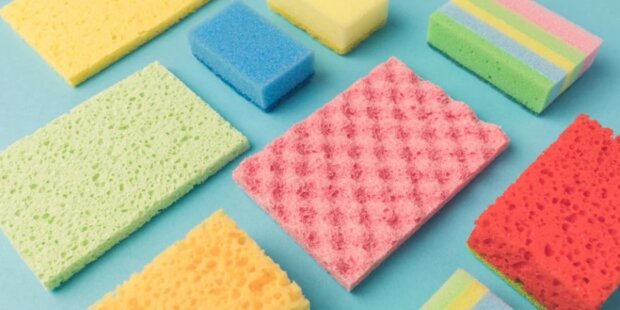Most people think that the color of sponges is a subjective preference of their manufacturers, a matter of taste, or a way to sell more.
Each sponge consists of two parts - a smaller layer of coarse material for scrubbing on one side and a soft, porous material for absorbing liquids or wiping dirty surfaces on the other side.
As reported: Fakta.today
This hard part is called the abrasive part. First, you should pay attention not to the color but to this abrasive part. The color of the abrasive part is an indicator of the sponge's stiffness.
The abrasive part is always a harder material used, for example, to remove limescale or residues of burnt food.

Sponges are not selected based on the color of the abrasive part, but on some other parameters, such as the size of the cleaning surface, the stiffness of the porous material, and its quality.
The color of the hard strip attached to the porous material is usually ignored. Yellow and green sponges are the most popular.
The yellow color provides careful washing. This sponge can be used for washing glass, crystal, porcelain.
The sponge with the yellow layer differs in the absence of abrasive particles, so such a sponge cannot remove limescale or dried dirt. Such models are specially made for cleaning delicate materials.
The green color means that the abrasive part of the sponge is very hard. With this sponge, you can easily clean frozen fat, burnt food, and their already dried residues. You should be more careful with such a sponge since it can damage enamel.
However, there are three other colors to indicate the stiffness of sponges, which are not as common.

Black indicates the maximum density of viscose and the content of abrasive substances.
These sponges are designed to remove limescale and stains and cannot be used on delicate surfaces.

Many housewives do not use black sponges on dishes at all. Such sponges are most often used for cleaning toilets, bathtubs, and sinks.
The blue color of the strip indicates a soft surface, and this sponge is as stiff as the yellow one. The model can be used for washing glass, with strong stains or residues of food, it may not cope.

The red or orange color of the abrasive part allows wiping food dry and can be used to wash enamel and Teflon. Such sponges can wipe serious dirt off delicate surfaces.

It is also worth noting that the shades of sponges may depend on the manufacturer.

Therefore, to avoid confusion, it is more advantageous to use sponges from one manufacturer.
If your house has a lot of delicate dishes, you should buy a few more yellow and red sponges.

For washing ordinary cups, plates, metal pans, and pots without a non-stick coating, use sponges with a green color. Black sponges should be used to remove the most difficult stains.
Read more: "As soon as it thaws, it loses its properties": Foods you should not freeze
As we wrote earlier: Quick recipe for cherry cake: when you want a tasty treat but don't want to stand by the stove





































